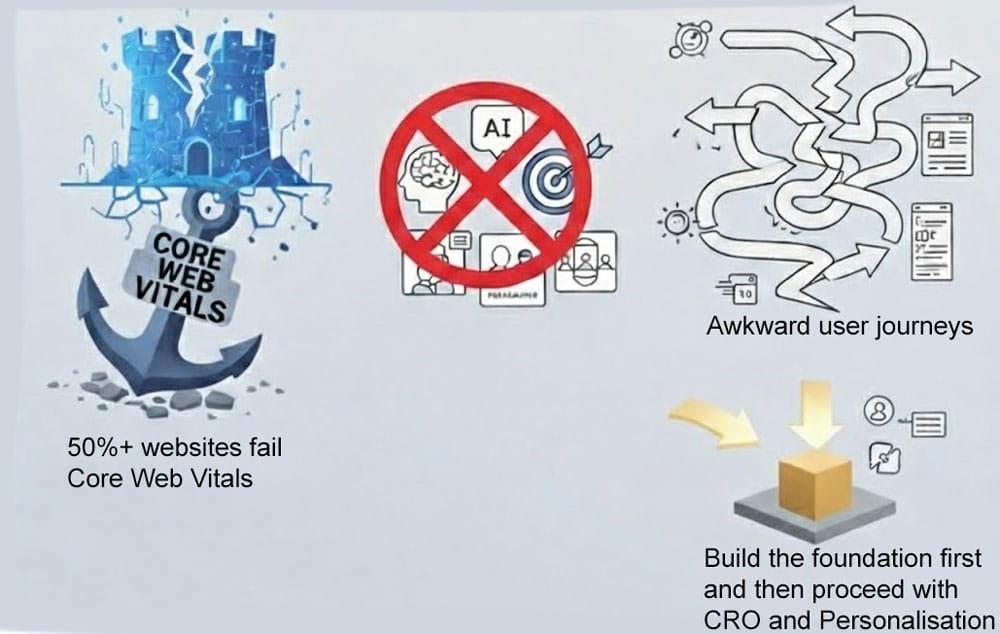Addressing the Elephant in the Room: Why Your MarTech Dreams Crash on the Rocks of Basic User Experience
We’re living in an exciting era for digital marketing. The buzzwords are intoxicating: Conversion Rate Optimisation (CRO), hyper-personalisation, and AI-driven experiences. Every company wants to harness the power of machine learning to predict user behaviour, craft bespoke journeys, and optimise every pixel for maximum conversion. The promise of these advanced strategies is huge, and rightfully so.
But here’s the uncomfortable truth: many businesses are building castles on quicksand.
While executives sign off on massive investments in sophisticated MarTech stacks, a fundamental flaw often undermines these ambitions: their websites and digital platforms lack the foundational user experience that makes any advanced strategy effective.
The Elephant in the Room: Core Web Vitals
Let’s talk about the absolute basics. Google’s Core Web Vitals (CWV) are not just an SEO metric; they are a direct measure of fundamental user experience. They assess how fast your page loads (Largest Contentful Paint), how quickly it responds to user input (Interaction to Next Paint), and how visually stable it is (Cumulative Layout Shift).
The startling reality? A significant majority of websites – well over 50% according to various reports – fail the Core Web Vitals assessment. In my opinion, much, much more.
Think about that for a moment. You’re investing in AI to personalise a user’s journey, but their first impression is a slow-loading page, content jumping about, or a frustrating delay when they try to click a button. You’re pouring resources into A/B testing minute changes, but the core experience is fundamentally broken for more than half your audience.
The "Awkward User Journey" Epidemic
This neglect of fundamentals leads directly to what I call the “awkward user journey.” These are the experiences where:
The page loads, but then a huge banner shifts everything down, causing the user to lose their place.
A user clicks a call-to-action, only to wait precious seconds for the page to respond, wondering if their click even registered.
Navigating between key sections feels clunky and unintuitive, making it a chore rather than a seamless flow.
Forms are overly long, poorly formatted, or lack clear error messaging, leading to abandonment.
Imagine a user arriving at your site, eager to learn more. They are immediately met with friction. No amount of “personalisation” can fix a page that takes too long to load or is a pain to interact with. If the basic act of browsing your site is a frustrating experience, they won’t stick around long enough to appreciate your sophisticated AI recommendations.
The Unsexy but Essential Work
Before we chase the next big thing in MarTech, we need to ask ourselves:
Is our website fast enough? (LCP, INP)
Is it visually stable? (CLS)
Is the navigation intuitive?
Are our forms easy to complete?
Is our content accessible and readable on all devices?
These aren’t glamorous tasks. Optimising images, streamlining code, improving server response times, and conducting thorough usability testing don’t generate the same headlines as “AI-powered customer journeys.” But they are the bedrock upon which all successful digital strategies are built.
Prioritise the Foundation, Then Innovate
The message isn’t to abandon CRO, personalisation, or AI. Far from it! These are powerful tools that, when used correctly, can transform businesses. However, their true potential can only be unlocked when the underlying user experience is solid.
Invest in your fundamentals first! Ensure your website is fast, stable, and delivers a smooth, intuitive experience. Fix those awkward user journeys! Only then will your sophisticated CRO efforts yield meaningful results, your personalisation feels genuinely helpful, and your AI implementations truly shine.
Boris Petrovic
